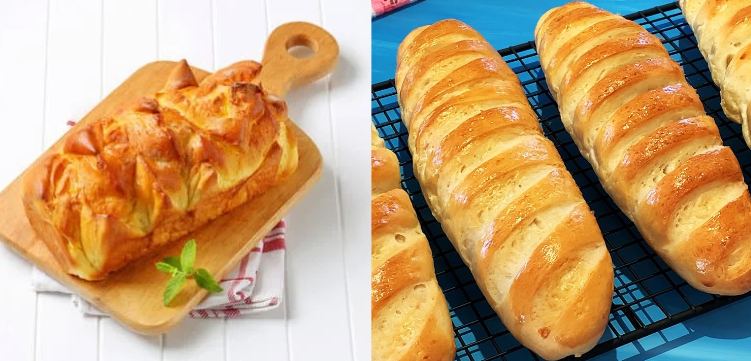You Won’t Believe the Difference Between Brioche and Vienna Bread!

What To Know
- Embark on a delectable journey as we delve into the world of brioche and Vienna bread, exploring their origins, ingredients, techniques, and the diverse applications that make them indispensable in the culinary landscape.
- Brioche boasts a generous amount of butter, eggs, and sugar, resulting in a rich, golden dough that yields a soft and flavorful crumb.
- It offers a good source of carbohydrates and fiber, making it a more balanced option for those seeking a healthier choice.
In the realm of pastries, brioche and Vienna bread stand as two of the most beloved and iconic culinary creations. Both renowned for their distinctive flavors, textures, and versatility, these breads have captivated taste buds and become integral parts of various cuisines worldwide. While they share some similarities, they also possess unique characteristics that set them apart. Embark on a delectable journey as we delve into the world of brioche and Vienna bread, exploring their origins, ingredients, techniques, and the diverse applications that make them indispensable in the culinary landscape.
Origins and History: A Tale of Two Continents
Brioche, with its rich and buttery flavor, traces its roots back to the kitchens of France. Its name, derived from the Old French word “broyer,” meaning “to knead,” hints at the meticulous process involved in its creation. Brioche’s popularity soared during the 16th century, becoming a staple in French bakeries and eventually spreading its charm across Europe.
Vienna bread, on the other hand, emerged from the heart of Austria. Its history is deeply intertwined with the city of Vienna, where it originated in the 19th century. This bread is characterized by its delicate crumb, crispy crust, and mild flavor, earning it a place of honor in Viennese coffee houses and bakeries.
Ingredients and Techniques: The Art of Breadmaking
Brioche and Vienna bread share a common foundation of essential ingredients: flour, water, yeast, and salt. However, the proportions and additional components employed in each recipe contribute to their distinct personalities.
Brioche boasts a generous amount of butter, eggs, and sugar, resulting in a rich, golden dough that yields a soft and flavorful crumb. The high butter content imparts a luxurious mouthfeel, while the eggs contribute to its distinctive color and structure.
Vienna bread, in contrast, is characterized by a leaner dough. It contains less butter, eggs, and sugar, resulting in a lighter and airier texture. The addition of malt or honey lends a subtle sweetness, balancing the bread’s delicate flavor profile.
The techniques used in crafting these breads also vary. Brioche undergoes an enriched dough process, where the butter is incorporated into the dough in stages, creating a laminated structure that contributes to its flaky layers. Vienna bread, on the other hand, employs a straight dough method, where all ingredients are mixed together at once, resulting in a more uniform crumb.
Applications and Culinary Versatility
Brioche and Vienna bread have earned their places as versatile culinary performers, gracing tables and menus in diverse settings.
Brioche’s rich flavor and soft texture make it a perfect choice for breakfast pastries, French toast, and bread pudding. Its ability to absorb liquids makes it ideal for soaking up sauces and gravies in savory dishes.
Vienna bread, with its mild flavor and crispy crust, shines as a sandwich bread, complementing a variety of fillings without overpowering them. Its airy crumb also makes it a popular choice for croutons and bread crumbs, adding a delightful crunch to salads, soups, and casseroles.
Nutritional Considerations: A Balanced Approach
While both brioche and Vienna bread offer culinary delights, they differ in their nutritional profiles.
Brioche, with its higher butter and egg content, is denser and more calorically dense than Vienna bread. It provides a good source of protein and fats, but its higher saturated fat content should be considered in moderation.
Vienna bread, with its leaner dough, is lower in calories and saturated fat. It offers a good source of carbohydrates and fiber, making it a more balanced option for those seeking a healthier choice.
Taste and Texture: A Sensory Experience
Brioche captivates the senses with its rich, buttery flavor and soft, velvety texture. The high butter content creates a luxurious mouthfeel, while the eggs contribute to its golden color and delicate crumb.
Vienna bread, in contrast, presents a lighter and airier texture. Its mild flavor allows the subtle sweetness of malt or honey to shine through, creating a harmonious balance. The crispy crust adds a delightful contrast to the soft crumb, making it a sensory delight.
Key Points: A Symphony of Culinary Delights
Brioche and Vienna bread, each with its unique characteristics and culinary strengths, stand as testaments to the artistry of breadmaking. Whether you prefer the rich decadence of brioche or the delicate charm of Vienna bread, these culinary treasures offer a symphony of flavors and textures that have captivated taste buds for centuries. As you embark on your next culinary adventure, let the aromas and flavors of these iconic breads transport you to a world of gastronomic delight.
Frequently Asked Questions:
Q: Can I substitute brioche for Vienna bread in recipes?
A: While brioche and Vienna bread share some similarities, they have distinct flavors and textures. Substituting one for the other may alter the intended outcome of a recipe.
Q: How can I store brioche and Vienna bread to maintain their freshness?
A: Store both brioche and Vienna bread in an airtight container at room temperature for up to 3 days. For longer storage, freeze them for up to 2 months.
Q: What are some creative ways to use brioche and Vienna bread?
A: Brioche can be used to make French toast, bread pudding, and croutons. Vienna bread is perfect for sandwiches, croutons, and bread crumbs. Both breads can be used to make delicious bread-based desserts.

